Output resolution is one of the most misunderstood topics in digital photography. What is the correct DPI or PPI to export an image to produce beautiful prints or display on a screen just right?
Unfortunately there is no simple answer; resolution, DPI, and PPI all represent different terms and, despite their interrelatedness, they stand as distinct concepts in the world of photography. So let’s dig deeper into a basic primer on output resolution and DPI.
First let’s look at each of the three terms individually. Resolution is the most important concept of the three, as it has a direct impact upon both DPI and PPI.
How Does This Work With Resolution?
Resolution refers to the quantity of pixels in an image. It typically comes from multiplying its width in pixels by its height in pixels.
Examples would be 640 x 480 or 1024 x 768 – common computer monitor display resolutions. The first example would be 640 pixels wide and 480 pixels tall (VGA resolution in tech speak). Digital photography often measures resolution in megapixels, quantifying the total number of pixels in millions.
You derive a megapixel by multiplying an image’s length by its width, accounting for all the individual pixels composing the image. A VGA image has 307,200 pixels in total; divide that by 1 million and you get .307 or 1/3 of a mega pixel.
To bring the resolution idea home a bit further, let’s look at a popular DSLR, the Canon 5D. The camera has a 12.8 mega pixel sensor, with a maximum image resolution of 4368 x 2912, or 12,719,616 pixels.
When taking images, feel free to think in terms of megapixels, but once you are ready to edit your images, it is a good idea to think of resolution in terms of length by width, it will make your life easier when it comes time to prep for print or web.
PPI And All Its Complexities
The next term we should consider is PPI or Pixels Per Inch. This concept refers to the amount of pixels that a computer monitor can display in a linear inch, or pixel density. Monitors vary greatly in the amount of pixels contained in an inch, but for standards sake, most refer to an average density of 72 pixels per inch.
When someone advises you to use 72 PPI or 72 DPI for a web image, it relates to the image’s display resolution on screens.
Pixels Per Inch is the proper terminology for pixel density on a monitor, but has been superseded in the vernacular by DPI or Dots Per Inch, and it the grand scheme of things it is just as well we use DPI for the concept.
Proper DPI is directly dependent upon the printer or digital-optical printing machine used for output.
DPI Demystified
DPI serves as the standard unit of print density for images, originally intended to measure printers’ print density. Much like PPI, DPI measures the amount of dots per linear inch. The higher the DPI, the more fine an image will print. However there is no “standard” correct DPI for printing images, as the proper DPI is directly dependent upon the printer or digital-optical printing machine used for output.
Some photo labs will recommend images be 300 DPI images, whilst others will ask for 240 DPI images. Ink jet printers will even differ from model to model as to the optimum print resolution, so it will pay to do some research on your particular model. General consensus is shoot for 300 DPI output density for Canon and HP printers and 360 DPI for Epson.
The Perfect Print
Now that we have covered the basic concepts, we can go on to formatting you images to the proper resolution and density to create optimum prints. Here I am going to draw a line in the sand that many will disagree with me on, but I have never had a complaint about prints I have printed for my customers.
In my opinion, when sending an image out to a pro lab, Wal-Mart, Jessop’s, Adorama Pix, or wherever you get prints made, you should export your images for print at 300 DPI….minimum. Others will say that you can get by with a lower print density, especially for larger sizes, and they are right as well.
I want to provide the photofinisher with every ounce of available quality. If their equipment prints at 240 DPI, it will ignore any extra image information. However, if it outputs at 300 DPI and I send in 150 DPI prints, the printer will either up-rez my image or print it at a suboptimal quality.
You can find your cameras native print resolution at 300 DPI simply by taking the length in pixels and divide by 300 and then do the same for height.
How resolution and DPI correlate
Let’s look back at the maximum image size for the Canon 5D again, 4368 x 2912. At 300 DPI the 5D’s native resolution prints at 14.56 inches wide and 9.71 inches tall. You can find your cameras native print resolution at 300 DPI simply by taking the length in pixels and divide by 300 and then do the same for height.
The results from the equations give you the native resolution of your camera in inches when printed at 300 DPI. This is useful to know, as if you desire to print bigger than the native print resolution, you will need to print at a lower print density or up-rez your image. Lowering print density for larger prints typically poses no issue, since people view larger prints from a greater distance.
To prove my point on exporting for print at 300 DPI for most situations, I created a sample image comparing 5 different exports of the same image exported for an 8×10 print. In Lightroom I exported the same image at 72, 150, 300, 360 and 600 DPI, opened them in Photoshop and zoomed in on an area of high detail.
All 5 frames have a similar zoom and crop in Photoshop and really show the difference in detail at different levels:
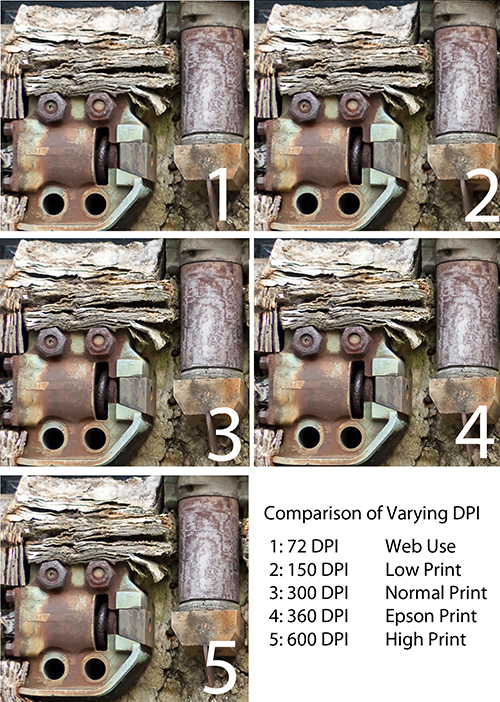
If you want to see the full size image, click here to open
Viewing this full resolution image above allows you to really see the difference between the different DPI levels. As you can see 72 DPI has horrible quality for print, at normal size 72 DPI look great on your monitor, but an 8×10 print at 72 DPI would look terrible.
150 DPI looks noticeably better than 75 DPI, but it does not compare well to 300 DPI. 150 can look fine when viewed at a reasonable distance on a large print, but under scrutiny it falls apart.
The Upper Limits Of DPI
The density of the pixels at these lower resolutions is not dense enough to trick the human eye into seeing smooth lines.
Now take some time and look really close at the 300, 360 and 600 DPI samples. Notice much difference? Neither do I. 300 DPI is just about perfect for prints that will be look at while held in your hand or viewed. As you increase DPI much further you start to meet the point of diminishing returns.
Theoretically a 600 DPI is much better than 300 DPI, but you also start to run into the resolving power of the human eye at that point. 360 DPI is special however, and should be used if printing to most Epson printers. For some reason Epson printers create images best at 360 DPI, but that has to do with Epson’s native printing DPI of 720 DPI. Most other inkjets will do fine at 300 DPI.
Now that you have seen the importance of DPI in printing, let’s talk about use on the web. Of course you want to have your images look the best when view on the web, for many of us our image’s appearance on a computer monitor is the difference between selling a print or not. All the knowledge of printing DPI is worthless if you don’t need to make prints.
As we discussed earlier, most computer monitors have a PPI somewhere in the neighborhood of 72 PPI. Some monitors have more pixel density, others less, but 72 PPI has become a de facto standard on the internet. In fact, it doesn’t matter if you export an image at 72 DPI or 720 DPI for the web, the computer will display the image at its native resolution regardless of how you export the image.
Where the PPI of the monitor and DPI of your image come into play for images on the web is the size you need your image to be. I export most of my images for web use with a long edge of 1000 pixels, which will keep the image viewable in either Portrait or Landscape format on the majority of modern monitors.
When that image is exported at 72 DPI with a long edge of 1000 pixels, the image will be about 13 inches long or tall when viewed on my meager 19 inch monitor. The same image printed at 13 inches long at 72 DPI would look terrible, but on a computer monitor it looks spectacular.
You want to resize images for web use to keep download times low and to deter unwanted use of your images.
You may want to go bigger, but my recommendation is to export for web with you long edge at 1000 pixels at 72 DPI. It’s big enough to appreciate the image, small enough to stay under 1 megabyte in size.
The Perfect DPI For Lightroom
Most DPI articles would now take the time to give you charts of minimum resolutions for different print sizes at differing DPI levels. It’s a safe assumption if you are viewing this blog then you probably have Lightroom, and that makes it pointless to waste time recreating a chart you can find anywhere on the Internet, so let’s take a few moments to walk through exporting images in Lightroom to the proper print DPI for a given print size.
First, find the image you are planning to export. In the Develop Module click on the crop tool and choose the crop ratio you want to export to:
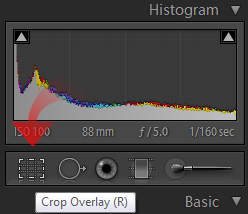
I am going to choose an 8×10 crop. If your crop size of choice is not listed, choose ‘Custom’ and enter your desired print size. Now go ahead and crop your image for your desired composition:
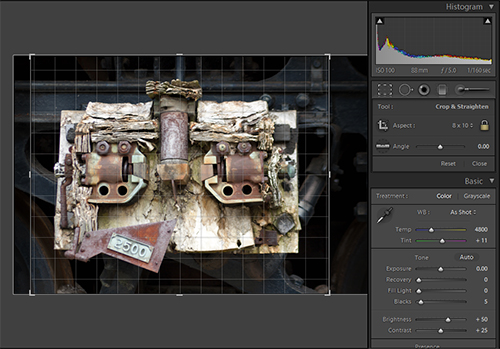
Hit Enter and make sure the crop looks good.
Now, right-click or control-click on the image to bring up the contextual menu:
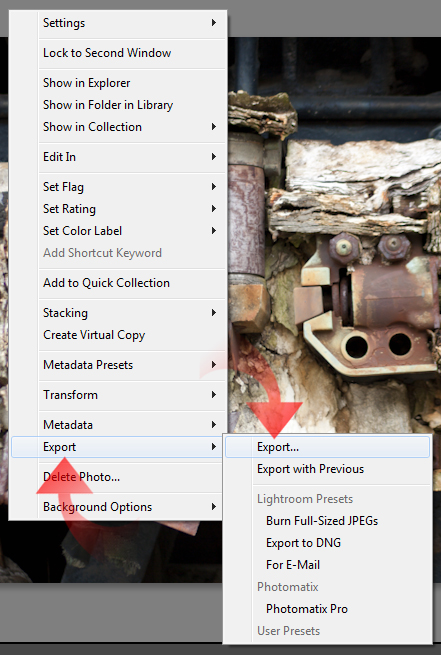
Select Export and then click Export in the sub-menu. Once the Export dialog box pops up, make sure it is set to the Files on Disk option at the top:
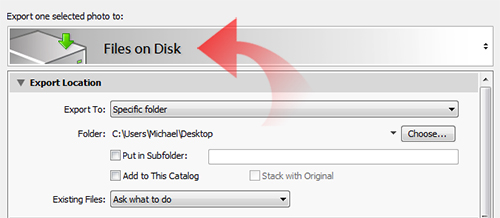
Set up all the export options the settings you desire for the image file, except for the Image Sizing options:
Now scroll to the Image Sizing tab. Make sure Resize to Fit: is checked:

Change the option box to Dimensions:

Now change the dimension option box to ‘in’ for inches (or cm if you deal in metric print sizes). Since I am exporting for an 8×10 print in Landscape orientation, I will then set the dimensions to 10 and 8:

Now make sure Don’t Enlarge is not checked, this will allow Lightroom to adaptively scale to image to increase resolution if needed:

Don’t worry, Lightroom does pretty good at up-rezzing for reasonable enlargements:

Finally, make sure the Resolution option box is set to pixels per inch. Since I am sending this image off to my local photo lab for printing, I also set the resolution to 300 pixels per inch (also known as DPI). Once everything is set, click the Export button.
Your image is now baked with proper resolution for a high quality print at the size you requested. No need for resolution charts, let Lightroom do the thinking for you.
Now to export for web use, start out in the Export dialog. Just as before, set all your options as you see fit. Make sure the Color Space option is set for sRGB (the default color space for the web).
Now in the Image Sizing tab, make sure Resize to Fit: is checked. Now set the option box to Long Edge:

Make sure the measurement option box is set to pixels. Now set the dimension to 1000:

For good measure set the pixels per inch option to 72 to create a 72 DPI image:

Click the Export button and let Lightroom do the work for you. Lightroom will scale-down your image to maintain the aspect ratio, setting the long edge of the photo to 1000 pixels. A nice small file that will create an image that fills most of any users screen, leaving in plenty of detail for viewing online.
Send It To Print!
Now you know how to wrangle Lightroom through the steps of making high quality files for both printing and web use. Lightroom does a good job of scaling your image up, but it has its limits. If you are going huge, like 20×30 or even 11×14 from a 6 megapixel camera, you need to export the file to Photoshop and increase the resolution with OnOne’s Genuine Fractals.
In my opinion it is the only way to make massive enlargements without losing a lot of quality. It’s adaptive enlarging utilizing their fractal technology can take your final file up to 800% its native size with minimal loss of quality. If you have to go big, OnOne is your best friend.
The process to increase size in Genuine Fractals is very similar to Lightroom’s, and if you have the plug-in you probably already know how to do this.
Hopefully this gave you a bit more understanding of DPI and resolution when it comes to printing or publishing to the web. When using Lightroom, you don’t have to sweat the details and resizing in Photoshop is not too different. Just make sure to choose the right settings for your use and Lightroom will take care of you.
Just remember 72 DPI for web, 300 DPI for print, and 360 DPI for printing to an Epson printer. Now go make some prints and don’t let anyone tell you 150 DPI is good enough for an 11×14, it might be fine from a few feet away, but you know someone is going to look close and ask why the picture looks like crap.


